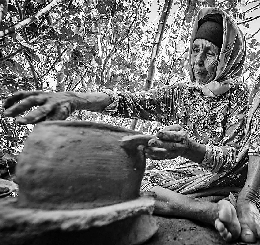
BEAUTIFUL handcrafted pottery made by Mama Aicha rarely sells in Morocco anymore but, thanks to social media, her ancient techniques are drawing students from around the world to the foothills of the Rif mountains. “When I heard about the workshop on Instagram, I signed up immediately because the practice is disappearing,” said Mirna Banieh, a young artist who traveled to Morocco from the West Bank town of Ramallah. “Mama Aicha is old and her knowledge must be passed down,” she added. Banieh’s four fellow students sit cross-legged on mats, their hands covered in clay learning from the 82-year-old potter. They came from London and Nairobi, Kenya, to a remote hamlet at the end of a rocky trail for a weeklong initiation. Their goal is to learn how to shape clay pieces by hand, dry them in the sun, fire them in a large open pit filled with wood, then polish them with stone before decorating them with natural pigments. Like everywhere in the Rif mountains, women potters from the Sless tribe, to which Aicha Tabiz’s family belongs, are vanishing. The tribe counted around 90 potters at the end of 1990s. Now, only a half-dozen remain. “The youth here don’t want to dirty their hands with clay. They dream of being officials with fixed salaries,” said the grandmother, whom everyone affectionately calls Mama Aicha. The ancestral knowledge that, according to some experts, dates back to the Bronze Age, is being lost little by little due to declining demand. “When I was young, everyone used clay pots and bowls for daily life and my mother sold them at market, but today everyone prefers plastic,” said Mohamed Tabiz, 53, Aicha’s eldest son. Researchers, collectors, enthusiasts are among the many that have warned for decades of the disappearance of this craft once passed down from generation to generation. “We wanted to establish a museum in the village,” Tabiz said. (SD-Agencies) | 
